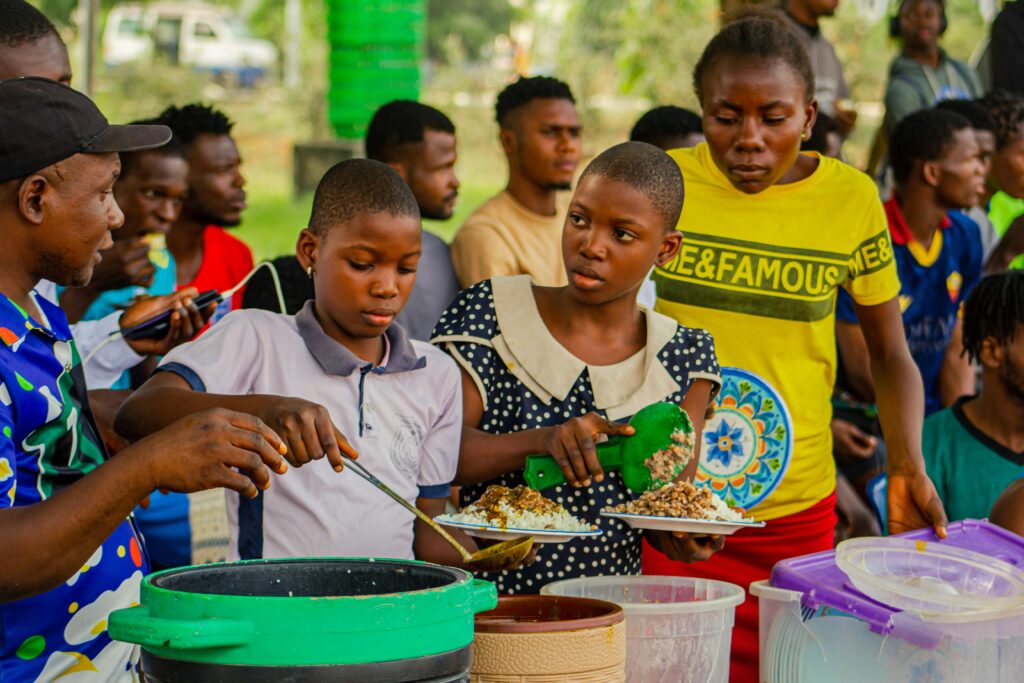support@socaa.org | +27 -739-045-948

Food Security Challenges
Food security is a critical issue for both impoverished communities and areas affected by disasters. Understanding the nuances of how food security becomes a problem in these contexts and the types of assistance needed can help in crafting effective responses.
Addressing food security in disaster-stricken areas and among impoverished communities requires a multifaceted approach. As a humanitarian organization, here are some effective strategies and actions you can take to provide assistance:
Food Security Challenges for Poor Communities
-
Economic Constraints:
- Low Income: Poor people often have insufficient income to buy enough food or to purchase nutritious food, leading to hunger or malnutrition.
- Food Prices: Volatility in food prices can disproportionately affect the poor, making basic food items unaffordable during economic downturns or inflation.
-
Limited Access to Resources:
- Land and Water: Many poor communities lack access to productive land and reliable water sources, making it difficult to grow their own food.
- Financial Services: Without access to credit or savings, it’s challenging for the poor to invest in agricultural inputs or cope with financial shocks.
-
Poor Infrastructure:
- Transport and Storage: Inadequate infrastructure can limit access to markets, making it difficult for poor farmers to sell their produce and for consumers to access fresh food.
- Supply Chain Issues: Poor storage facilities lead to significant post-harvest losses, reducing the availability of food and income for smallholder farmers.
-
Social Inequality:
- Marginalization: Certain groups (e.g., women, ethnic minorities) often face discrimination that limits their access to food and resources.
- Education and Awareness: Lack of education on nutrition and food preparation can contribute to poor dietary choices and malnutrition.
-
Health Issues:
- Malnutrition: Chronic lack of food and nutrients leads to malnutrition, which can cause stunted growth, weakened immune systems, and other health problems.
- Disease Burden: Poor health exacerbates food insecurity, as illness can reduce the ability to work and earn income, and increase medical expenses.
Food Security Challenges in Disaster-Stricken Areas
-
Disruption of Food Supply Chains:
- Production Losses: Natural disasters can destroy crops, livestock, and fisheries, drastically reducing local food production.
- Transport Disruptions: Damaged roads, bridges, and ports can hinder the transportation of food supplies to and from affected areas.
-
Displacement and Loss of Livelihoods:
- Forced Migration: Disasters often force people to leave their homes and lands, leading to loss of livelihoods and creating difficulties in accessing food.
- Unemployment: Destruction of businesses and agricultural lands results in loss of jobs and income, making it harder for people to afford food.
-
Market Dysfunction:
- Price Spikes: Disasters can cause immediate spikes in food prices due to reduced supply and increased demand.
- Market Collapse: Local markets may shut down or become inaccessible, making it difficult for people to buy or sell food.
-
Damage to Infrastructure and Services:
- Utility Failures: Destruction of water, sanitation, and power systems can compromise food safety and hygiene, increasing the risk of foodborne illnesses.
- Health Services: Overwhelmed or damaged healthcare systems struggle to address malnutrition and disease outbreaks.
-
Psychological and Social Stress:
- Trauma and Uncertainty: The stress of dealing with a disaster can affect mental health and decision-making, impacting food choices and consumption patterns.
- Community Breakdown: Social networks and community support systems often get disrupted, reducing the shared resources and support available for food security.
Assistance Needed in Poor and Disaster-Stricken Areas
Immediate and Short-Term Assistance
Emergency Food Aid:
- Food Distribution: Provide emergency food rations to meet immediate hunger needs, focusing on vulnerable groups like children, the elderly, and pregnant women.
- Cash and Voucher Assistance: Offer cash transfers or food vouchers that allow people to purchase food from local markets, supporting both recipients and local businesses.
Nutrition Support:
- Supplementary Feeding Programs: Set up programs to provide nutrient-rich foods to malnourished individuals, especially young children and nursing mothers.
- Therapeutic Feeding: In cases of severe malnutrition, provide therapeutic foods and medical care to restore health and prevent mortality.
Restoration of Livelihoods:
- Cash-for-Work Programs: Engage local populations in community rebuilding efforts (e.g., clearing debris, repairing infrastructure) in exchange for cash or food.
- Microgrants and Loans: Provide financial support to help people restart small businesses or agricultural activities.
Infrastructure Repair:
- Restoring Supply Chains: Work on repairing roads, bridges, and market facilities to reestablish the flow of goods and services.
- Water and Sanitation Services: Rebuild water systems and sanitation facilities to ensure safe food preparation and consumption.
Mid to Long-Term Assistance
Agricultural and Economic Support:
- Seed and Tool Distribution: Provide seeds, tools, and training to farmers to help them resume or improve agricultural production.
- Microfinance Programs: Offer access to credit and savings facilities to help communities invest in food production and manage financial risks.
Capacity Building:
- Training and Education: Conduct training on modern farming techniques, nutrition, food preservation, and small business management.
- Community Development: Support community-led initiatives that improve local food security, such as cooperatives and local food systems.
Sustainable Food Systems:
- Climate-Resilient Agriculture: Promote practices and crops that are resilient to local climate conditions and reduce the risk of future food insecurity.
- Diversification: Encourage diversification of crops and income sources to reduce reliance on a single type of production or livelihood.
Social Protection Systems:
- Safety Nets: Develop and strengthen social protection programs (e.g., food stamps, social grants) to support vulnerable populations in times of crisis.
- Insurance Programs: Introduce or expand agricultural insurance to protect farmers from crop losses due to disasters.
